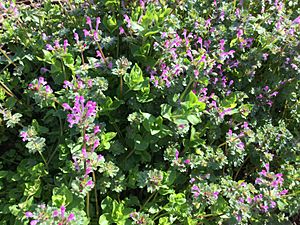Common henbit facts for kids
Quick facts for kids Common henbit |
|
|---|---|
 |
|
| Scientific classification | |
| Genus: |
Lamium
|
| Species: |
amplexicaule
|
Henbit, also known as common henbit, is a small plant found in many parts of the world. Its scientific name is Lamium amplexicaule. It originally comes from Europe, Asia, and northern Africa.
This plant is an annual plant, which means it lives for only one growing season. It usually grows to be about 10–25 cm (3.9–9.8 in) tall. Henbit has soft, slightly hairy stems. Its leaves grow in pairs opposite each other. They are round, about 2–3 cm (0.79–1.18 in) wide, and have wavy edges. The flowers are pink to purple and are about 1.5–2 cm (0.59–0.79 in) long. The name amplexicaule means "stem-clasping," which describes how the leaves wrap around the stem.
What Does Henbit Look Like?
Henbit is an annual plant that spreads out along the ground. It has short, upright stems that are square-shaped and slightly hairy. It can grow up to about 40 cm (16 in) tall.
The leaves grow in pairs. The lower leaves have stalks, but the upper ones do not. The upper leaves often join together and wrap around the stems. The leaves are hairy and shaped like kidneys, with rounded teeth along their edges.
The flowers are quite large and grow in clusters at the top of the plant. They also grow in rings around the stem where the leaves meet. The outer part of the flower, called the calyx, has five parts and closes up after the flower blooms. The petals are purplish-red and form a tube about 15 to 20 mm (1⁄2 to 3⁄4 in) long. The top part of the flower is curved, about 3 to 5 mm (1⁄8 to 3⁄16 in) long. The bottom part has three lobes. Two are small side ones, and a larger central one is about 1.5 to 2.5 mm (1⁄16 to 1⁄8 in) long. Henbit flowers have four stamens (the parts that make pollen), two long and two short. The plant produces a fruit with four chambers.
This plant blooms very early in the spring, even in colder places. In warmer areas like the Mediterranean region, it can flower throughout the winter and early spring. When there are not many pollinating insects around, the flowers can pollinate themselves.
Where Does Henbit Grow?
Henbit probably first grew in the Mediterranean region. But now, it has spread all over the world. You can find it growing in open areas, gardens, fields, and meadows.
It spreads easily by seed. Sometimes, entire fields can look reddish-purple because of all its flowers before farmers plow the land in spring. Where it is common, henbit is a very important source of nectar and pollen for bees, especially honeybees. It helps them get a good start in the spring.
Henbit has become common in eastern North America and other places. However, people often let it grow because it looks nice, is edible, and grows well in many climates. Even though it is common, henbit is not seen as a threat to local environments. It actually helps by giving nectar to pollinators and food for animals. Many types of birds also eat its seeds.
How Can Henbit Be Used?
The young leaves and shoots of henbit can be eaten raw or cooked. You can also eat the stems and flowers. Henbit has a slightly sweet and peppery taste, similar to celery.
See also
 In Spanish: Lamium amplexicaule para niños
In Spanish: Lamium amplexicaule para niños


